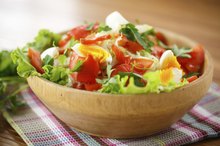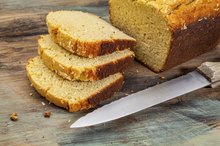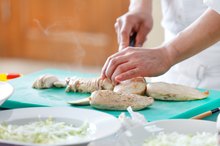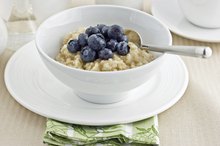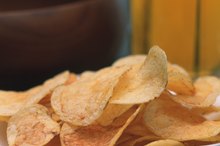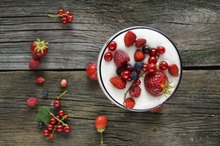A Weight-Loss Plan for Celiac Disease
Celiac disease is estimated to affect 1 in 100 of the world's population, according to the Celiac Disease Foundation 1. Moreover, an estimated 2.5 million Americans have undiagnosed celiac disease. If you have been diagnosed with this autoimmune disorder, you must follow a gluten-free diet for the rest of your life to keep the symptoms and risks at bay 3. This means that you can't follow just any weight-loss plan because many are filled with gluten-containing foods. You'll have no trouble developing a celiac-friendly weight-loss plan, though -- many gluten-free foods are also low-calorie.
Celiac Restrictions
Wheat, barley and rye contain gluten, the protein that causes an immune reaction in those with celiac disease. Even small amounts of these foods -- think a breadcrumb or a wheat-based sauce thickener -- can trigger celiac reactions. Scan food labels carefully to determine if the food contains any gluten additives or ingredients, or if it was processed in a facility where possible gluten contamination could occur.
Basic Celiac Diet
How to Follow a No Flour, No Sugar Diet
Learn More
Like any diet, a celiac-friendly weight-loss plan requires calorie restriction. To lose 1 pound per week, subtract 500 from your average daily intake. Find your average intake by recording the calories you eat for a week and dividing the total number by seven. Once you know your daily calorie limit, track the calories in every food and drink you consume and do not go over this number. Base your celiac-friendly diet around low-calorie, whole foods like lean meats, fish, eggs, low-fat dairy, fruits, berries and vegetables. Most of these foods will not have a nutritional label, but you can look up their calories on a database like the U.S. Department of Agriculture's National Nutrient Database. When possible, avoid processed "gluten-free" foods, which often have as many, if not more, calories than their gluten-containing counterparts.
- Like any diet, a celiac-friendly weight-loss plan requires calorie restriction.
- Once you know your daily calorie limit, track the calories in every food and drink you consume and do not go over this number.
Sample Day
A sample low-calorie, celiac-friendly menu could start with two scrambled eggs, a fresh orange and a cup of spinach for breakfast. Chicken salad with balsamic vinegar dressing and a sprinkling of almonds makes a hearty lunch. To satisfy midday hunger, have a handful of berries and a glass of low-fat milk, soy milk or sugar-free fruit juice as a snack. And finally, for dinner, try steamed salmon with asparagus and brown rice on the side.
- A sample low-calorie, celiac-friendly menu could start with two scrambled eggs, a fresh orange and a cup of spinach for breakfast.
- To satisfy midday hunger, have a handful of berries and a glass of low-fat milk, soy milk or sugar-free fruit juice as a snack.
Exercise Regimen
How to Lose 15 Pounds in One Month
Learn More
Working out will help you burn more calories and lose more weight. Find an exercise regimen you enjoy and aim to work out for about 30 minutes between three and five times weekly. Hiking, swimming, cycling, in-line skating, aerobics, jogging, dancing, weightlifting or any other exercise you enjoy is fine.
Health Warnings
Going gluten-free without the initial guidance of a physician can lead to nutrient deficiencies. For example, fortified bread products are a significant source of B vitamins in the American diet. Ask your health-care professional for assistance in choosing the right supplements to combat deficiencies and keep your body healthy.
Related Articles
References
- Celiac Disease Foundation: What Is Celiac Disease?
- Harvard Health Publications: Simple Math Equals Easy Weight Loss
- CNN Health: Will a Gluten-Free Diet Improve Your Health?
- Roszkowska A, Pawlicka M, Mroczek A, Bałabuszek K, Nieradko-iwanicka B. Non-Celiac Gluten Sensitivity: A Review. Medicina (Kaunas). 2019;55(6) doi:10.3390/medicina55060222
- Jones AL. The Gluten-Free Diet: Fad or Necessity? Diabetes Spectr. 2017;30(2):118–123. doi:10.2337/ds16-0022
- Parzanese I, Qehajaj D, Patrinicola F, et al. Celiac disease: From pathophysiology to treatment. World J Gastrointest Pathophysiol. 2017;8(2):27–38. doi:10.4291/wjgp.v8.i2.27
- Elli L, Branchi F, Tomba C, et al. Diagnosis of gluten related disorders: Celiac disease, wheat allergy and non-celiac gluten sensitivity. World J Gastroenterol. 2015;21(23):7110–7119. doi:10.3748/wjg.v21.i23.7110
- Choi JM, Lebwohl B, Wang J, et al. Increased prevalence of celiac disease in patients with unexplained infertility in the United States. J Reprod Med. 2011;56(5-6):199–203.
- Elkan AC, Sjöberg B, Kolsrud B, Ringertz B, Hafström I, Frostegård J. Gluten-free vegan diet induces decreased LDL and oxidized LDL levels and raised atheroprotective natural antibodies against phosphorylcholine in patients with rheumatoid arthritis: a randomized study. Arthritis Res Ther. 2008;10(2):R34. doi:10.1186/ar2388
- Leonard MM, Cureton P, Fasano A. Indications and Use of the Gluten Contamination Elimination Diet for Patients with Non-Responsive Celiac Disease. Nutrients. 2017;9(10):1129. Published 2017 Oct 18. doi:10.3390/nu9101129
- Rai S, Kaur A, Chopra CS. Gluten-Free Products for Celiac Susceptible People. Front Nutr. 2018;5:116. Published 2018 Dec 17. doi:10.3389/fnut.2018.00116
Writer Bio
Serena Styles is a Colorado-based writer who specializes in health, fitness and food. Speaking three languages and working on a fourth, Styles is pursuing a Bachelor's in Linguistics and preparing to travel the world. When Styles isn't writing, she can be found hiking, cooking or working as a certified nutritionist.
